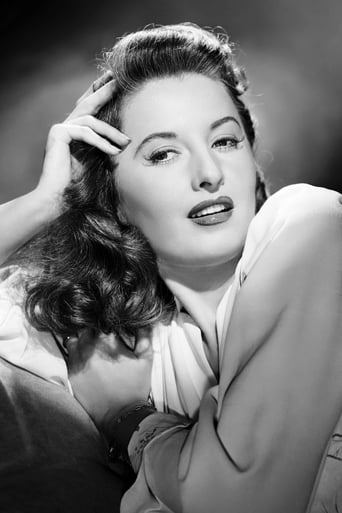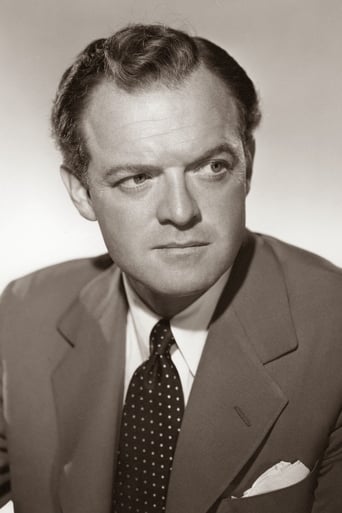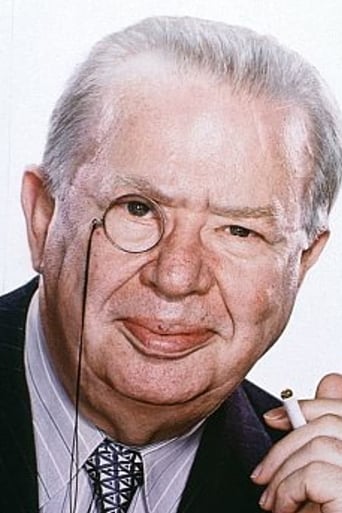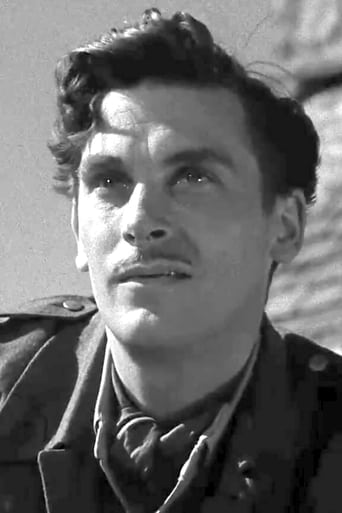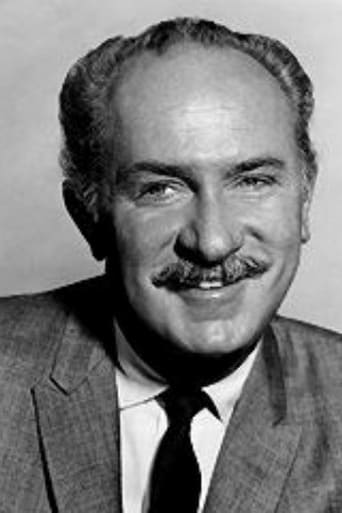CommentsXp
Best movie ever!
Kien Navarro
Exactly the movie you think it is, but not the movie you want it to be.
Deanna
There are moments in this movie where the great movie it could've been peek out... They're fleeting, here, but they're worth savoring, and they happen often enough to make it worth your while.
Zlatica
One of the worst ways to make a cult movie is to set out to make a cult movie.
calvinnme
Charles Coburn plays the self made man of industry (B.F. Fulton) who has one child, Polly (Barbara Stanwyck), who is not just his daughter but a confidante and even a protégé of sorts about business matters. Meanwhile, B.F.'s wife (Spring Byington) is pretty much wasted here as she spends the entire film knitting.Polly is in love with an attorney, Robert S. Tasmin III, who refuses to marry Polly until he works his way up to assistant partner. Meanwhile, while Bob is up on that corporate ladder, down on the ground Polly meets her friend Apples (Margaret Lindsay) for a drink in a nearby tavern. Educator and lecturer Tom Brett (Van Heflin), zeroes in on Polly and they start talking politics. Polly seems to fall for Tom because of his Bohemian lifestyle and his stylish rudeness that she never encountered in her circles. Within 24 hours they are married. Brett's good buddy is a leftist radio host, Martin Ainsley (Keenan Wynn), who is always talking down rich people in general and B.F. in particular.Yet it is B.F. who comes across as the good guy. He doesn't try to interfere in his daughter's life and seems to genuinely care about his employees. So Polly and Tom start out marriage in a log cabin in Minnesota where Tom is working on his book. Meanwhile, Polly figures - "How can a little financial boost hurt?". She goes to somebody running a nationwide lecture tour and promises to cover his losses if he will hire her husband. Tom knows nothing of this, but once he is out on the circuit his ideas are a big hit. Ultimately, his books and lectures become very profitable and Brett becomes a rich guy too, a member of FDR's brain trust.Will success change Tom Brett? Was Ainsley a phony in the first place? Will Tom and Polly's marriage work out? Watch and find out.I only gave this a six because the adapted screenplay was a bit of a sprawling saga for just under two hours. This film was supposed to be set from the Great Depression years into the midst of WWII, and it was adapted from a novel written in 1946. B.F. and Polly, symbols of the wealthy class, are showcased as the real people here, and Brett and Ainsley ultimately are the stuffy and unbending types with the same character flaws they have been ascribing to the rich.One big negative I would give it - It doesn't try at all to dress people in the clothes of the period. Stanwyck is wearing the same kind of tailored suit that was popular in 1948 at the beginning of the film - which was the early 1930's, and Heflin, who is supposed to be poor, wears a wrinkled suit from the late 1940s himself.The script is a bit of a muddle - it does not follow the novel, especially the last half , but I'd watch it for the acting and for an object lesson in the production code really REALLY trying to make rich people look like misunderstood benefactors, especially just prior to the red scares. It's definitely NOT boring.
blanche-2
Barbara Stanwyck is "B.F.'s Daughter" in this 1948 film, with Charles Coburn as B.F., Van Heflin, Keenan Wynn, and Spring Byington.This film is based on a controversial novel with a different, more political emphasis and turned into a romantic soap opera by MGM.Stanwyck plays Pauline, from a wealthy family, who is engaged to marry Bob Tasmin (Richard Hart), someone she's known for years. However, she meets a good-looking and interesting left-wing economy professor, author, and lecturer, Thomas Brett (Heflin) and falls in love with him. They get married right away and move to a cabin in Minnesota. Polly, or Paul as she is called, takes an allowance from her father with Tom's blessing - however, he's made it clear he's not interested in B.F.'s money or B.F.'s interest in his career.Unbeknownst to him, Pauline uses her father's connections to get Tom started on the lecture circuit. He becomes very successful, and Pauline is determined to help him be a great man and furnishes a fabulous house in Connecticut - which he hates and announces that he won't be returning there. He becomes a big mucky-muck in Washington as war approaches. Meanwhile, Pauline sees her marriage falling apart.One of the points of the book was that the common man was the true patriot and true American, and Marquand, the author, took the liberal approach of resentment toward the rich. Some of this is softened in the film, though it's obvious that B.F. and Tom come from very different places ideologically. In MGM's hands, this is a clash of ideologies that gets in the way of a marriage.I found the performances terrific from everyone, but especially Stanwyck, who is lovely and sincere, and Heflin, a wonderful actor who left us too soon, and a fine leading man or character actor, whatever the role called for.The story certainly held my interest, but I felt that the Heflin character was too rigid. It's a tougher world today in which to make a career than it was in the '40s, okay, and it's admirable to want to "make it on your own," but even with connections, if you can't cut the mustard, you won't have success. Obviously Tom was a talented man and good speaker and once he got started, did very well. There is nothing wrong with getting help at the bottom of the ladder - I took issue with this and found it naive. Also, knowing the relationship his wife had with her father, to disrespect him as he did in the party scene was wrong.I think just about anything with Barbara Stanwyck in it is worth seeing, and I also feel that way about Van Heflin. And the supporting cast of Coburn, Byington, Wynn, and Margaret Lindsey are very good. The script is a little problematic, but the cast elevates it.
st-shot
Barbara Stanwyck gets to turn the faucets on for three different men as well as model some pricey threads in BF's Daughter. While clearly a star driven vehicle the storyline itself is a paean to American capitalism summed up in the benign performance of Charles Coburn as a fair minded captain of industry and the abrasive wrongheaded muck wracking of an agitator commentator played by Keenan Wynn.Polly is the spoiled daughter of industrialist BF Fulton. Engaged to be married she has her head turned by a progressive man of the people, Tom Brett ( Van Heflin ) who has little use for the money of men like BF. She marries Brett who rejects her lifestyle even though it is her money that brings him exposure and fame. The two drift, BF gets ill and the ex-paramour flies off on a dangerous mission giving Polly plenty to fret about.BF suffers from too much comparison to other works involving the cast. Stanwyck's spoiled rich girl doesn't seem to dig as deep as she does in Sorry, Wrong Number. Her father daughter reprise with Coburn worked better when they were on the other side of the law in The Lady Eve. The same can be said with Heflin in The Strange Love of Martha Ivers. Robert Z. Leonard's direction is sound and cinematographer Joseph Ruttenberg delivers some stunning compositions but the story itself is a soapy melodrama that ultimately turns to sap.
gerdeen-1
The original book about a tycoon's daughter marrying a left-wing economist was one of John P. Marquand's less cheerful novels. The plot had the economist taking a high-ranking civilian job in World War II while his one-time "establishment" rival joined the military and was given a dangerous assignment. Some critics attacked the book as a smack at liberals' love of country, while its defenders saw it as an antidote to wartime stories that celebrated the "common man" as the only true patriot. The movie glides over all that serious business, changing the class conflicts from serious issues to mere impediments to true love. While preserving a considerable number of the book's situations and even large chunks of its dialogue, the movie changes everything that's important, turning the couple's serious marital problems into simple misunderstandings. The result is a mostly dull romance, with Heflin and Stanwyck showing little chemistry. It would have been better if the filmmakers had gone further and turned the story into a comedy.
